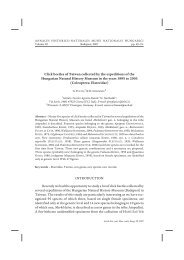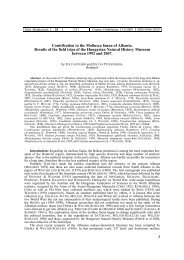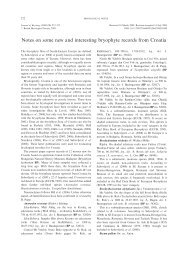new records on the bryophytes of mt voras, north greece
new records on the bryophytes of mt voras, north greece
new records on the bryophytes of mt voras, north greece
Create successful ePaper yourself
Turn your PDF publications into a flip-book with our unique Google optimized e-Paper software.
Studia bot. hung. 37, pp. 145–155, 2006<br />
NEW RECORDS ON THE BRYOPHYTES<br />
OF MT VORAS, NORTH GREECE<br />
E. TSAKIRI 1 ,B.PAPP 2 and E. SZURDOKI 2<br />
1 Laboratory <strong>of</strong> Systematic Botany and Phytogeography, Department <strong>of</strong> Botany<br />
Aristotle University <strong>of</strong> Thessal<strong>on</strong>iki, Thessal<strong>on</strong>iki 541 24, Greece; tsakiri@bio.auth.gr<br />
2<br />
Department <strong>of</strong> Botany, Hungarian Natural History Museum<br />
H-1476 Budapest, Pf. 222, Hungary; pappbea@bot.nhmus.hu, szurdoki@bot.nhmus.hu<br />
During a brief study trip to document Sphagnum habitats <strong>on</strong> two sites <strong>of</strong> Mt Voras in Central Maced<strong>on</strong>ia,<br />
North Greece, our collecti<strong>on</strong>s revealed a number <strong>of</strong> <str<strong>on</strong>g>new</str<strong>on</strong>g> <str<strong>on</strong>g>records</str<strong>on</strong>g>. Three taxa (Ditrichum<br />
pusillum, Polytrichum commune var. perig<strong>on</strong>iale, and Sphagnum angustifolium) are first recorded in<br />
Greece. Areas covered with Sphagnum species are rare in <strong>the</strong> country and <strong>the</strong>se represent <strong>the</strong> sou<strong>the</strong>rn<br />
distributi<strong>on</strong> limit <strong>of</strong> this habitat type so relevant in more nor<strong>the</strong>rly areas <strong>of</strong> Europe.<br />
Key words: <strong>bryophytes</strong>, Mt Voras, <str<strong>on</strong>g>new</str<strong>on</strong>g> and interesting species, North Greece<br />
INTRODUCTION<br />
With regard to its bryophyte flora Greece is a poorly explored country; this is<br />
also true for <strong>the</strong> whole regi<strong>on</strong> <strong>of</strong> sou<strong>the</strong>astern Europe. The knowledge <strong>on</strong> <strong>bryophytes</strong><br />
can mainly be thanked to foreign scientists who occasi<strong>on</strong>ally visit Greece<br />
and report <strong>on</strong> <strong>the</strong>ir findings (SABOVLJEVIĆ et al. 2001). Despite <strong>the</strong> somewhat random<br />
research d<strong>on</strong>e <strong>on</strong> <strong>bryophytes</strong>, until now ca 730 bryophyte taxa were reported<br />
for <strong>the</strong> country (PRESTON 1981, 1984a, b, DÜLL 1995). Additi<strong>on</strong>al data can be<br />
ga<strong>the</strong>red from older papers (overlooked by <strong>the</strong> above menti<strong>on</strong>ed authors) as well<br />
as in recently published articles (e.g. MAVROMMATIS 1972, ATHANASIADIS 1977,<br />
GALLEGO and CANO 1998, PAPP et al. 1998, 1999, ROS et al. 2001, BLOCKEEL et<br />
al. 2002, PAPP 2002, 2003, LARA et al. 2003, LÜTH 2002, TSAKIRI et al. 2006,<br />
PARENT and DE ZUTTERE 2006). Almost every publicati<strong>on</strong> provides <str<strong>on</strong>g>new</str<strong>on</strong>g> <str<strong>on</strong>g>records</str<strong>on</strong>g><br />
for <strong>the</strong> country and even more can be expected (DÜLL 1996, SÖDERSTRÖM et al.<br />
1998).<br />
From <strong>the</strong> overall distributi<strong>on</strong> data <strong>of</strong> <strong>the</strong> <strong>bryophytes</strong> it is evident that most <strong>of</strong><br />
<strong>the</strong> informati<strong>on</strong> is referring to island areas (Aegean and I<strong>on</strong>ian islands) with <strong>the</strong> island<br />
<strong>of</strong> Crete, which is probably <strong>the</strong> bryologically best investigated area in Greece.<br />
But <strong>the</strong> c<strong>on</strong>tinental parts <strong>of</strong> Greece have not been explored at <strong>the</strong> same level, and<br />
<strong>the</strong> available publicati<strong>on</strong>s are limited in number and scope.<br />
For <strong>the</strong> nor<strong>the</strong>rn part <strong>of</strong> <strong>the</strong> mainland <strong>of</strong> Greece, more specifically <strong>the</strong> administrative<br />
regi<strong>on</strong> <strong>of</strong> North Greece (Districts <strong>of</strong> Maced<strong>on</strong>ia and Thrace, including <strong>the</strong><br />
islands <strong>of</strong> Thasos and Samothraki), approximately 500 bryophyte taxa are re-<br />
Studia Botanica Hungarica 37, 2006<br />
Hungarian Natural History Museum, Budapest
146 TSAKIRI, E., PAPP, B. and SZURDOKI, E.<br />
ported. Since <strong>the</strong> first publicati<strong>on</strong> c<strong>on</strong>cerning North Greece, <strong>the</strong> “Florae Graecae<br />
Prodromus”(SIBTHORP and SMITH 1806–1813) with a collecti<strong>on</strong> from Mt Athos,<br />
<strong>the</strong> total number <strong>of</strong> bryophyte publicati<strong>on</strong>s for <strong>the</strong> area, unfortunately, is less than<br />
thirty in number, even though North Greece provides much better natural c<strong>on</strong>diti<strong>on</strong>s<br />
for <strong>the</strong> bryophyte vegetati<strong>on</strong> than <strong>the</strong> island areas. Here are located some <strong>of</strong><br />
<strong>the</strong> highest mountains <strong>of</strong> <strong>the</strong> country (e.g. Olympos (2,917 m), Smolikas (2,637 m),<br />
etc.), and a large number <strong>of</strong> aquatic habitats (rivers, lakes, lago<strong>on</strong>s) (DÜLL 1995,<br />
TSAKIRI et al. 1998).<br />
Sphagnum data for Greece<br />
Generally speaking, Sphagnum is extremely rare in Greece. Reports <strong>on</strong> Sphagnum<br />
occurrences are scarce, and such areas represent a very rare vegetati<strong>on</strong> type <strong>of</strong><br />
extremely great scientific interest in Greece, because <strong>the</strong>y represent <strong>the</strong> sou<strong>the</strong>rn<br />
distributi<strong>on</strong> limit <strong>of</strong> this genus characteristic in more nor<strong>the</strong>rly habitat types <strong>of</strong> Europe.<br />
To date, <strong>on</strong>ly eight species <strong>of</strong> Sphagnum have been reported from Greece.<br />
Their presence for <strong>the</strong> country was first reported by MAZZIARI (1851), who collected<br />
Sphagnum palustre L. (= S. cymbifolium (Ehrh.) Hedw.) and S. subsecundum<br />
Nees <strong>on</strong> <strong>the</strong> island <strong>of</strong> Corfu. Mazziari’s publicati<strong>on</strong> was followed by:<br />
–JURATZKA (1861) who reported S. capillifolium (Ehrh.) Hedw. from <strong>the</strong> I<strong>on</strong>ian<br />
and <strong>the</strong> Aegean Islands (in PRESTON 1984b). Recently, this species was also reported<br />
by DÜLL (1995) from Corfu,<br />
–MAVROMMATIS (1972) reported <strong>the</strong> presence <strong>of</strong> any Sphagnum species for <strong>the</strong><br />
first time in North Greece (S. subsecundum Nees, from <strong>the</strong> Rhodope mountain range,<br />
“Elatia” area, N Drama Prefecture),<br />
–ATHANASIADIS (1977) collected four species <strong>of</strong> Sphagnum from seven different<br />
areas <strong>of</strong> North Greece (S. c<strong>on</strong>tortum Schultz – Rhodope Mts: “Elatia” area, Mt<br />
Lailias, Mt Voras: “Mplatsa” area; S. subsecundum Nees – Mt Chaidou, Mt Voras:<br />
“Kampos” area; S. palustre – Mt Lailias, Mt Voras: “Kampos” area, Mt Pieria:<br />
“Kokkini Vrysi” area; S. squarrosum Pers. (Cr.) – Mt Pieria: “Kokkini Vrysi” and<br />
“Flambouro” areas. Athanasiadis also suggested <strong>the</strong> correcti<strong>on</strong> <strong>of</strong> Mavrommatis’ taxa<br />
from <strong>the</strong> Rhodope Mts to S. c<strong>on</strong>tortum.<br />
–GEISSLER (1977) reported S. palustre and S. subsecundum from Mt Lailias<br />
(Serres Prefecture, East Maced<strong>on</strong>ia District),<br />
–GIANNITSAROS and KOUMPLI-SOVANTZI (1990) reported S. cuspidatum<br />
Ehrh. ex H<strong>of</strong>fm. from Lesvos (Mytilini) island (NE Aegean),<br />
–TURLAND and WILSON (1995) collected S. auriculatum Schimp. from <strong>the</strong> island<br />
<strong>of</strong> Crete,<br />
Studia bot. hung. 37, 2006
BRYOPHYTES FROM NORTH GREECE 147<br />
–PARENT and DE ZUTTERE (2006) have published <strong>the</strong> most recent report based<br />
<strong>on</strong> an earlier collecti<strong>on</strong> from 1984 c<strong>on</strong>taining S. teres (Schimp.) Ångstr. (Mt Voras,<br />
W–NW Pella Perfecture).<br />
The reports <strong>of</strong> MAZZIARI (1851), JURATZKA (1861) and GEISSLER (1977) are<br />
also included in PRESTON (1984b) and DÜLL (1995).<br />
Based <strong>on</strong> <strong>the</strong> existing publicati<strong>on</strong>s four Sphagnum species may be c<strong>on</strong>nected to<br />
<strong>the</strong> Mt Voras area: Sphagnum subsecundum and S. palustre from “Kali Pediada” (or<br />
“Kampos”) area, NW <strong>of</strong> Loutraki and S. c<strong>on</strong>tortum from “Mplatsa” area, N <strong>of</strong> Aridea<br />
(Pella Prefecture) (ATHANASIADIS 1977), and S. teres collected W <strong>of</strong> Loutraki (PAR-<br />
ENT and DE ZUTTERE 2006).<br />
In additi<strong>on</strong>, <strong>the</strong>re are two reports by GEISSLER (1977) and ZOLLER et al. (1977)<br />
from Pella Prefecture, which c<strong>on</strong>tain bryophyte informati<strong>on</strong> from sites N and NW <strong>of</strong><br />
Aridea (Mt Voras) at elevati<strong>on</strong>s between 1000–1500 m a.s.l.<br />
MATERIALS AND METHODS<br />
Study area<br />
Mt Voras, <strong>the</strong> third highest mountain in Greece, is situated in central North Greece (Central<br />
Maced<strong>on</strong>ia District, Pella Prefecture) running al<strong>on</strong>g <strong>the</strong> nor<strong>the</strong>rn border <strong>of</strong> Greece as a natural border<br />
with <strong>the</strong> neighbouring country <strong>of</strong> <strong>the</strong> Former Yugoslav Republic <strong>of</strong> Maced<strong>on</strong>ia (FYROM) and reaching<br />
2,524 m in altitude (Kaimaktsalan peak).<br />
The area is a proposed site for protecti<strong>on</strong> in <strong>the</strong> framework <strong>of</strong> “Natura 2000” project named<br />
“Koryfes Orous Voras” (Dir. 92/43/EEC) (DAFIS et al. 1996). It is a large area <strong>of</strong> about 39,000 hectares<br />
with its landscape dominated by gentle slopes, with <strong>the</strong> excepti<strong>on</strong> <strong>of</strong> rugged gorges around <strong>the</strong><br />
Loutraki area. The area was not affected by excessive human populati<strong>on</strong> and activities until recently<br />
(around <strong>the</strong> year 2000) when <strong>the</strong>y started to build a network <strong>of</strong> roads, mainly with <strong>the</strong> aim <strong>of</strong> <strong>the</strong> c<strong>on</strong>structi<strong>on</strong><br />
<strong>of</strong> a nearby ski centre.<br />
Geologically, <strong>the</strong>re is a great variability <strong>of</strong> substrates comprised <strong>of</strong> limest<strong>on</strong>e, schist, gneiss<br />
and ophioliths.<br />
There are extensive, densely forested areas that hold a significant asset <strong>of</strong> timber (mainly<br />
Fagus sylvatica subsp. sylvatica forests), and extensive pastures supporting stock raising and deep valleys<br />
with a variety <strong>of</strong> habitat types, such as acidophilous (Luzulo-Fagetum) beech forests; beech forests<br />
with Ilex aquifolium and Taxus baccata rich in epiphytes (Ilici-Fagi<strong>on</strong>); nitrophilous (Asperulo-Fagetum)<br />
beech forests; beech forests with Abies borisii-regis, Juniperus communis formati<strong>on</strong>s <strong>on</strong> calcareous<br />
heaths or grasslands; active raised bogs; alkaline fens; residual alluvial forests (Alni<strong>on</strong> glutinoso-incanae);<br />
gallery forests dominated by Salix alba and Populus alba; acidophilous spruce forests<br />
(Vaccinio-Piceetea); black pine forests <strong>of</strong> Pinus nigra subsp. pallasiana, etc. The area is also significant<br />
because <strong>of</strong> <strong>the</strong> presence <strong>of</strong> relict stands <strong>of</strong> Pinus peuce, and some areas with Quercus trojana<br />
woods, both vegetati<strong>on</strong> types with a very limited distributi<strong>on</strong> in Greece. Also remarkable is <strong>the</strong> presence<br />
<strong>of</strong> an active bog in <strong>the</strong> “Kali Pediada” area, a unique feature for <strong>the</strong> country (DAFIS et al. 1996).<br />
Bogs and fens are rare types <strong>of</strong> habitat in Greece and <strong>the</strong>y appear in three forms: (i) raised bogs<br />
(habitat code 7110, represented with 2 areas in <strong>the</strong> country); (ii) alkaline fens (habitat code 7230, 12<br />
Studia bot. hung. 37, 2006
148 TSAKIRI, E., PAPP, B. and SZURDOKI, E.<br />
areas); and (iii) calcareous fens (habitat code 7210, 13 areas). Raised bogs and calcareous fens are included<br />
in <strong>the</strong> priority habitat types <strong>of</strong> <strong>the</strong> Habitat Directive <strong>of</strong> <strong>the</strong> European Uni<strong>on</strong> (Annex I,<br />
92/43/EEC) (DAFIS et al. 1996).<br />
There are <strong>on</strong>ly two active (and very small-sized) bogs recorded in Greece: (i) <strong>the</strong> previously<br />
menti<strong>on</strong>ed <strong>on</strong>e at “Kali Pediada” (Mt Voras, Prefecture Pella), and (ii) at “Elatia” (in <strong>the</strong> Rhodope<br />
mountain range, Drama Prefecture).<br />
Methods<br />
A short visit was made to Mt Voras (30–31.08.2000), previously known for <strong>the</strong> presence <strong>of</strong> Sphagnum<br />
species (ATHANASIADIS 1977).<br />
Two alkaline fens with Sphagnum species were visited (Fig. 1); both were situated in open areas.<br />
The first is located at <strong>the</strong> “Voras-Kaimaktsalan ski centre”, about half a kilometre before <strong>the</strong> chalet<br />
(N <strong>of</strong> Agios Athanasios village). There were no previous collecti<strong>on</strong>s from here before. The sec<strong>on</strong>d<br />
is <strong>the</strong> active bog at <strong>the</strong> area <strong>of</strong> “Kali Pediada” (NW <strong>of</strong> Loutraki) by <strong>the</strong> country’s nor<strong>the</strong>rn border line,<br />
which is c<strong>on</strong>sidered as <strong>the</strong> largest active bog in Greece (DAFIS et al. 1996), and it is <strong>the</strong> collecti<strong>on</strong> area<br />
named “Kampos” menti<strong>on</strong>ed by ATHANASIADIS (1977).<br />
All alkaline fens in Greece (Carex davalliana dominated) are reported mainly from high altitudes,<br />
from <strong>the</strong> mountainous areas <strong>of</strong> Maced<strong>on</strong>ia and <strong>the</strong> Pindos mountain range (e.g. Smolikas,<br />
Agrafa and Aspropotamos Mts).<br />
Both areas are situated in North Greece, Central Maced<strong>on</strong>ia District, Pella Prefecture, Mt<br />
Voras. The exact coordinates are:<br />
Site 1: Lat.: 40° 54’ 32” N; L<strong>on</strong>g.: 21° 48’ 40” E, Alt.: 2,050 m a.s.l.<br />
Site 2: Lat.: 41° 02’ 14” N; L<strong>on</strong>g.: 21° 53’ 30” E, Alt.: 1,750 m a.s.l.<br />
Around Site 1 <strong>the</strong>re are alpine and subalpine heaths. Species-rich Nardus grasslands growing <strong>on</strong> siliceous<br />
substrates, Fagus sylvatica forests with Abies borisii-regis, nitrophilous (Asperulo-Fagetum) and<br />
acidophilous (Luzulo-Fagetum) beech forests and black pine stands <strong>of</strong> Pinus nigra subsp. pallasiana<br />
forests are also found in <strong>the</strong> surroundings.<br />
Site 2 is surrounded by subalpine and alpine tall herb communities; in <strong>the</strong> broader area species-rich<br />
Nardus grasslands grow <strong>on</strong> siliceous substrates, al<strong>on</strong>g with alpine and subalpine heaths and<br />
reforested mountain slopes with acidophilous (Luzulo-Fagetum) and nitrophilous (Asperulo-Fagetum)<br />
beech forests.<br />
The specimens collected have been deposited in <strong>the</strong> Herbarium <strong>of</strong> <strong>the</strong> Hungarian Natural History<br />
Museum, Budapest (BP), and in <strong>the</strong> Herbarium <strong>of</strong> <strong>the</strong> Aristotle University <strong>of</strong> Thessal<strong>on</strong>iki<br />
(TAU).<br />
Nomenclature and <strong>the</strong> European distributi<strong>on</strong> data follow DÜLL and MEINUNGER (1989) and<br />
DÜLL (1995).<br />
The floristical results have been analysed according <strong>the</strong> latest available check-list <strong>of</strong> DÜLL<br />
(1995), updated with all <strong>the</strong> <str<strong>on</strong>g>new</str<strong>on</strong>g> <str<strong>on</strong>g>records</str<strong>on</strong>g> for Greece. For <strong>the</strong> distributi<strong>on</strong> <strong>of</strong> bryophyte taxa <strong>the</strong><br />
floristical regi<strong>on</strong>s <strong>of</strong> Greece are used, according to <strong>the</strong> “Flora Hellenica” project (STRID and TAN<br />
1997) with <strong>the</strong> differentiati<strong>on</strong> accepted for <strong>bryophytes</strong> by PRESTON (1981). The abbreviati<strong>on</strong>s used<br />
for <strong>the</strong> Greek floristical areas and <strong>the</strong>ir definiti<strong>on</strong>s are <strong>the</strong> following: CR (Crete), RH (Rhodos island),<br />
AE: Th (Aegean islands: Thasos), IO (I<strong>on</strong>ian islands), PE (Pelop<strong>on</strong>nisos), ST (Sterea Hellas), EU<br />
(Euboea), PI (Pindos), EC (East Central), NC (North Central, Thessalia), NE: At, Ch, Rd (North East:<br />
Athos, Chalkidiki, Rhodope Mts).<br />
Studia bot. hung. 37, 2006
BRYOPHYTES FROM NORTH GREECE 149<br />
RESULTS AND DISCUSSION<br />
Seventeen taxa <strong>of</strong> mosses were identified, am<strong>on</strong>g which <strong>the</strong>re are three <str<strong>on</strong>g>new</str<strong>on</strong>g> <str<strong>on</strong>g>records</str<strong>on</strong>g><br />
for <strong>the</strong> bryophyte flora <strong>of</strong> Greece: Ditrichum pusillum (Hedw.) Hampe, Polytrichum<br />
commune var. perig<strong>on</strong>iale (Michx.) Hampe, Sphagnum angustifolium (C.<br />
Jens. ex Russ.) C. Jens (Table 1).<br />
All <strong>of</strong> <strong>the</strong> collected <str<strong>on</strong>g>records</str<strong>on</strong>g> bel<strong>on</strong>g to <strong>the</strong> North-Central (NC) floristical area<br />
<strong>of</strong> Greece.<br />
Bryum schlecheri DC., a boreal-m<strong>on</strong>tane species, was previously collected<br />
<strong>on</strong>ly by UNGER (1862) and SCHIFFNER (1915), <strong>on</strong>ly from island areas (Crete and<br />
Euboea corresp<strong>on</strong>dingly). For this species, it is <strong>the</strong> first collecti<strong>on</strong> from mainland<br />
Greece. Also Palustriella decipiens (De Not.) Ochyra, a subarctic-subalpine species,<br />
was previously collected <strong>on</strong>ly by COPPEY (1908) from <strong>the</strong> Pindos (PI) area.<br />
According to DÜLL (1995), both species required verificati<strong>on</strong>. For <strong>the</strong> North-Cen-<br />
Fig. 1. North Greece and <strong>the</strong> locati<strong>on</strong> <strong>of</strong> <strong>the</strong> collecti<strong>on</strong> sites at Mt Voras (Pella Prefecture, Greece).<br />
Altitudinal lines are at 500 (pale grayish), 1,000, 1,500 and 2,000 m a.s.l. (black). The asterisks (*) indicate<br />
<strong>the</strong> sites <strong>of</strong> collecti<strong>on</strong> (and <strong>the</strong> locati<strong>on</strong> <strong>of</strong> Mt Voras in <strong>the</strong> map <strong>of</strong> Greece).<br />
Studia bot. hung. 37, 2006
150 TSAKIRI, E., PAPP, B. and SZURDOKI, E.<br />
Table 1. List <strong>of</strong> <strong>the</strong> collected species. Previous reports and <str<strong>on</strong>g>new</str<strong>on</strong>g> data for <strong>the</strong> floristical areas <strong>of</strong> Greece are also menti<strong>on</strong>ed, as well as European distributi<strong>on</strong>.<br />
An asterisk (*) before <strong>the</strong> species name indicates <strong>the</strong> <str<strong>on</strong>g>new</str<strong>on</strong>g> reports for <strong>the</strong> bryophyte flora <strong>of</strong> Greece. The floristical areas <strong>of</strong> Greece where<br />
<strong>the</strong>y were collected are also menti<strong>on</strong>ed (for details <strong>of</strong> <strong>the</strong> abbreviati<strong>on</strong>s and definiti<strong>on</strong>s see <strong>the</strong> Methods). NNC = <str<strong>on</strong>g>new</str<strong>on</strong>g> for North Central Greece<br />
Taxa Sites Previous reports NNC European<br />
distributi<strong>on</strong><br />
1 2<br />
Brachy<strong>the</strong>cium rivulare B., S. et G. + RH, AE: Th, IO, PE, ST, PI, EC, NC, NE: Ch, Rd subbor<br />
Bryum schleicheri DC. + CR (SCHIFFNER 1915), EU (UNGER 1862) + bor-m<strong>on</strong>t<br />
Callierg<strong>on</strong>ella cuspidata (Hedw.) Loeske + CR, AE: Th, IO, PI, NC, NE temp<br />
Campylium stellatum (Hedw.) C. Jens. ex J. Lange + NC (GANIATSAS 1937) bor<br />
*Ditrichum pusillum (Hedw.) Hampe + + temp<br />
Drepanocladus aduncus (Hedw.) Warnst. + PE, ST, EU, PI, NE: At + temp<br />
F<strong>on</strong>tinalis antipyretica Hedw. + CR, AE: Th, IO, PE, EU, PI, NC, NE subbor<br />
Palustriella decipiens (De Not.) Ochyra + PI (COPPEY 1908) + subarc-sub<br />
alp<br />
Pog<strong>on</strong>atum aloides (Hedw.) P. Beauv. + CR, AE: Th, IO, PE, EU, PI, EC, NC, NE:Ch temp<br />
Polytrichum alpinum Hedw. + NC (VAJDA 1959), unlocalised (KINDBERG<br />
1887)<br />
subarc-sub<br />
alp<br />
*Polytrichum commune var. perig<strong>on</strong>iale (Michx.) Hampe + + subbor<br />
*Sphagnum angustifolium (C. Jens. ex Russ.) C. Jens. + + subbor<br />
Sphagnum denticulatum Brid. (= S. auriculatum Schimp.) + CR + n.suboc<br />
Sphagnum squarrosum (Pers.) Cr. + + NC (ATHANASIADIS 1977) temp<br />
Sphagnum subsecundum Nees ex Sturm + IO, NE, NC (ATHANASIADIS 1977) bor<br />
Sphagnum teres (Schimp.) Ångstr. ex C. Hartm. + NC (PARENT and DE ZUTTERE 2006) bor(-m<strong>on</strong>t)<br />
Warnstorfia exannulata (Schimp.) Loeske + NE + borp<br />
Studia bot. hung. 37, 2006
BRYOPHYTES FROM NORTH GREECE 151<br />
tral (NC) floristical area <strong>the</strong>re is a total <strong>of</strong> 8 taxa that have been first reported, including<br />
all <strong>of</strong> <strong>the</strong> above menti<strong>on</strong>ed taxa and also Drepanocladus aduncus (Hedw.)<br />
Warst., Sphagnum denticulatum Brid. and Warnstorfia exannulata (Schimp.)<br />
Loeske (Table 1).<br />
Sphagnum teres (Schimp.) Ångstr. ex C. Hartm. was recently reported from<br />
Mt Voras by PARENT and DE ZUTTERE (2006).<br />
Campylium stellatum (Hedw.) C. Jens. ex J. Lange (GANIATSAS 1937) and<br />
Polytrichum alpinum Hedw. (KINDBERG 1887, VAJDA 1959) have been found<br />
again in <strong>the</strong> same (NC floristical) area after a l<strong>on</strong>g time since <strong>the</strong>ir previous reports<br />
(Table 1).<br />
From Site 1 10 taxa were identified, all <strong>of</strong> <strong>the</strong>m are <str<strong>on</strong>g>new</str<strong>on</strong>g> reports for <strong>the</strong> site and<br />
<strong>of</strong> which 2 are <str<strong>on</strong>g>new</str<strong>on</strong>g> bryophyte reports for Greece. This is also <strong>the</strong> sec<strong>on</strong>d collecti<strong>on</strong><br />
site <strong>of</strong> Sphagnum teres (Table 1). The first collecti<strong>on</strong> <strong>of</strong> this species by Parent in<br />
<strong>the</strong> year 1984 was made at <strong>the</strong> same part <strong>of</strong> <strong>the</strong> mountain as “Site 1”, but at a lower<br />
altitude (1,800 m a.s.l. according to Parent’s descripti<strong>on</strong> <strong>of</strong> <strong>the</strong> collecti<strong>on</strong> area)<br />
(PARENT and DE ZUTTERE 2006). During our visit in <strong>the</strong> area (16 years later) this<br />
place was not found again, thus we think that due to <strong>the</strong> road c<strong>on</strong>structi<strong>on</strong> in <strong>the</strong><br />
mountain this first collecti<strong>on</strong> site <strong>of</strong> <strong>the</strong> species may have disappeared forever.<br />
From Site 2 (“Kali Pediada”) 8 taxa were reported, n<strong>on</strong>e <strong>of</strong> <strong>the</strong>m previously<br />
reported from this area, and <strong>on</strong>e is a <str<strong>on</strong>g>new</str<strong>on</strong>g> record for <strong>the</strong> bryophyte flora <strong>of</strong> Greece<br />
(Table 1).<br />
Interestingly, we could not find Sphagnum subsecundum and S. palustre menti<strong>on</strong>ed<br />
by <strong>the</strong> <strong>on</strong>ly existing publicati<strong>on</strong> <strong>on</strong> <strong>the</strong> area by ATHANASIADIS (1977), but<br />
instead S. angustifolium and S. squarrosum were collected by us.<br />
The three Sou<strong>the</strong>ast European countries close to <strong>the</strong> study area are FYROM,<br />
are Serbia and Bulgaria. Based <strong>on</strong> <strong>the</strong> available bryophyte check-lists for <strong>the</strong>se<br />
countries (DÜLL et al. 1999, SABOVLJEVIĆ and STEVANOVIĆ 1999, NATCHEVA<br />
and GANEVA 2005) it is c<strong>on</strong>cluded that besides Greece, Sphagnum denticulatum is<br />
<strong>on</strong>ly reported from Bulgaria. The rest <strong>of</strong> <strong>the</strong> species has already been reported from<br />
more than <strong>on</strong>e <strong>of</strong> <strong>the</strong>se countries (Table 2).<br />
According to <strong>the</strong> European distributi<strong>on</strong> categories (DÜLL 1995) it is clear that<br />
our specimens reflect <strong>the</strong> nor<strong>the</strong>rn character <strong>of</strong> <strong>the</strong> study sites. 9 taxa bel<strong>on</strong>g to <strong>the</strong><br />
“boreal” group (incl. 4 subboreal, 3 boreal and 2 boreal-m<strong>on</strong>tane species); 2 species<br />
are subarctic-subalpine elements; 5 <strong>bryophytes</strong> are species <strong>of</strong> temperate z<strong>on</strong>es<br />
<strong>of</strong> Europe, and 1 species has <strong>north</strong>-suboceanic distributi<strong>on</strong> (Table 1).<br />
Studia bot. hung. 37, 2006
152 TSAKIRI, E., PAPP, B. and SZURDOKI, E.<br />
C<strong>on</strong>servati<strong>on</strong> informati<strong>on</strong> and threatening factors<br />
The reported species are not included in <strong>the</strong> Red Data Book <strong>of</strong> European<br />
Bryophytes (ECCB 1995), and according to <strong>the</strong> Greek Legal System <strong>the</strong> <strong>bryophytes</strong><br />
in general are not included in any law c<strong>on</strong>cerning nature and flora protecti<strong>on</strong>.<br />
In <strong>the</strong> Greek Habitat Project “Natura 2000” (Dir. 92/43/EEC) <strong>on</strong>e species is<br />
included (Buxbaumia viridis (Moug.) Moug. et Nestl.; DAFIS et al. 1996). But this<br />
does not represent <strong>the</strong> “real needs” for Greek bryophyte protecti<strong>on</strong>. Especially in<br />
<strong>the</strong> case <strong>of</strong> all Sphagnum areas in Greece, which are extremely vulnerable mainly<br />
due to <strong>the</strong>ir extremely small size and also <strong>the</strong> disturbing human activities, which<br />
pose a great threat <strong>on</strong> <strong>the</strong>se sites and even <strong>the</strong>re is a real danger <strong>of</strong> extincti<strong>on</strong>.<br />
At Site 1, by <strong>the</strong> “ski centre Voras”, <strong>the</strong> small alkaline fen is extremely threatened<br />
by human activities and <strong>the</strong> plans <strong>of</strong> expanding <strong>the</strong> ski centre to serve an increasing<br />
number <strong>of</strong> visitors experienced over <strong>the</strong> last years.<br />
Table 2. Occurrence <strong>of</strong> <strong>the</strong> reported taxa in <strong>the</strong> neighbouring countries <strong>of</strong> sou<strong>the</strong>astern Europe.<br />
Data available by SABOVLJEVIĆ and STEVANOVIĆ (1999) for Federal Republic <strong>of</strong> Yugoslavia<br />
(Serbia and M<strong>on</strong>tenegro), DÜLL et al. (1999) for FYROM and NATCHEVA and GANEVA (2005) for<br />
Bulgaria.<br />
Serbia M<strong>on</strong>tenegro FYROM Bulgaria<br />
Brachy<strong>the</strong>cium rivulare + + + +<br />
Bryum schleicheri + + + +<br />
Callierg<strong>on</strong>ella cuspidata + + + +<br />
Campylium stellatum + + + +<br />
Ditrichum pusillum + +<br />
Drepanocladus aduncus + + + +<br />
F<strong>on</strong>tinalis antipyretica + + + +<br />
Palustriella decipiens + + +<br />
Pog<strong>on</strong>atum aloides + + +<br />
Polytrichum alpinum + + + +<br />
Polytrichum commune var. perig<strong>on</strong>iale + + +<br />
Sphagnum angustifolium + +<br />
Sphagnum denticulatum +<br />
Sphagnum squarrosum + + + +<br />
Sphagnum subsecundum + + +<br />
Sphagnum teres + + +<br />
Warnstorfia exannulata + + + +<br />
Studia bot. hung. 37, 2006
BRYOPHYTES FROM NORTH GREECE 153<br />
At Site 2, “Kali Pediada”, plans have been laid out about <strong>the</strong> possible draining<br />
out by <strong>the</strong> Forest Service, which has various development plans for <strong>the</strong> area (pers.<br />
comm. by Pr<strong>of</strong>. Dr Athanasiadis).<br />
Although both sites are included in <strong>the</strong> Corine Biotops (biotope codes: 51.1 &<br />
54.23) (CEC 1991) and Natura 2000 sites <strong>of</strong> Greece (DAFIS et al. 1996), <strong>the</strong> threats<br />
are obvious.<br />
The area can be visited throughout <strong>the</strong> year, which means expanded possibilities<br />
<strong>of</strong> explorati<strong>on</strong> and indeed <strong>the</strong>re is an alarmly growing pressure <strong>on</strong> <strong>the</strong> sites.<br />
Unique areas for Greece, like <strong>the</strong> above discussed special locati<strong>on</strong> for Sphagnum,<br />
especially Site 1 by <strong>the</strong> ski centre, being increasingly well accessed through<br />
improved road c<strong>on</strong>diti<strong>on</strong>s, might be <strong>the</strong> most excellent display areas for ecotourism<br />
and c<strong>on</strong>nected activities. Such initiatives would be exemplary ways <strong>of</strong> combining<br />
<strong>the</strong> local people’s prospectives with <strong>the</strong> goals <strong>of</strong> nature c<strong>on</strong>servati<strong>on</strong> thus preserving<br />
<strong>the</strong> local culture and well-being with <strong>the</strong> native flora and vegetati<strong>on</strong>.<br />
* * *<br />
Acknowledgement – We are grateful to <strong>the</strong> Head and <strong>the</strong> staff <strong>of</strong> <strong>the</strong> Aridea Forest Service<br />
(Pella Prefecture) for <strong>the</strong>ir kind assistance to show us around Mt Voras and its small but unique<br />
bryophyte areas during our short visit with Pr<strong>of</strong>. Dr S. DAFIS, DrE.PAPASTERGIADOU and M.<br />
PANAGIOTOPOULOU (Forester), and to Pr<strong>of</strong>. Dr N. ATHANASIADIS for sharing relevant informati<strong>on</strong><br />
for <strong>the</strong> areas discussed.<br />
REFERENCES<br />
ATHANASIADIS, N. (1977): Sphagnum c<strong>on</strong>tortum Schultz, Sph. subsecundum Nees, Sph. palustre L.<br />
and Sph. squarrosum Pers. (Cr.) four <str<strong>on</strong>g>new</str<strong>on</strong>g> species <strong>of</strong> <strong>the</strong> Greek flora. – Aristotle University <strong>of</strong><br />
Thessal<strong>on</strong>iki. Sci. Ann. Agr<strong>on</strong>omic and Forestry School 10: 263–281. (in Greek)<br />
BLOCKEEL, T. L., ROS, R. M., SABOVLJEVIĆ, M., CANO, M. J., GALLEGO, M. T., and MUÑOZ, J.<br />
(2002): New and interesting bryophyte <str<strong>on</strong>g>records</str<strong>on</strong>g> for Greece. – Cryptogamie, Bryology 23(2):<br />
149–155.<br />
CEC (Commissi<strong>on</strong> <strong>of</strong> <strong>the</strong> European Communities) (1991): CORINE biotopes manual. Habitats <strong>of</strong> <strong>the</strong><br />
European Community. Part 2. – Brussels, Luxembourg, 232 pp.<br />
COPPEY, A. (1908): C<strong>on</strong>tributi<strong>on</strong> à l’Étude des Muscinées de la Grèce. – Bull. Soc. Sc. Nancy 3:<br />
1–70.<br />
DAFIS, S., PAPASTERGIADOU, E., GEORGHIOU, K., BABALONAS, D., GEORGIADIS, T., PAPAGEOR-<br />
GIOU, M., LAZARIDOU, TH. and TSIAOUSSI, V. (1996): Directive 92/43. EEC The Greek<br />
“Habitat” Project NATURA 2000: An Overview. – Life C<strong>on</strong>tract B4–3200/94/756, Commissi<strong>on</strong><br />
<strong>of</strong> <strong>the</strong> European Communities DG XI, The Goulandris Natural History Museum, Greek<br />
Biotope/Wetland Centre, 1000 pp.<br />
DÜLL, R. (1995): Bryophytes <strong>of</strong> Greece. – Bryol. Beiträge 10: 1–229.<br />
DÜLL, R. (1996): The current state <strong>of</strong> bryophyte investigati<strong>on</strong> in <strong>the</strong> Mediterranean area. – Bocc<strong>on</strong>ea<br />
5: 271–278.<br />
Studia bot. hung. 37, 2006
154 TSAKIRI, E., PAPP, B. and SZURDOKI, E.<br />
DÜLL, R. and MEINUNGER, L. (1989): Deutschlands Moose. Teil 1. Anthocerotae, Marchantiatae,<br />
Bryatae: Sphagnidae, Andreaeidae, Bryidae: Tetraphidales–Pottiales. – IDH-Verlag, Bad<br />
Münstereifel, 368 pp.<br />
DÜLL, R., GANEVA, A., MARTINČIČ, A. and PAVLETIĆ, Z. (1999): C<strong>on</strong>tributi<strong>on</strong>s to <strong>the</strong> bry<strong>of</strong>lora <strong>of</strong><br />
former Yugoslavia and Bulgaria. – IDH-Verlag, Bad Münstereifel, 199 pp.<br />
ECCB (1995): Red Data Book <strong>of</strong> European Bryophytes. – European Committee for C<strong>on</strong>servati<strong>on</strong> <strong>of</strong><br />
Bryophytes, Tr<strong>on</strong>dheim, 291 pp.<br />
GALLEGO, M.T.andCANO, M. J. (1998): Aloina brevirostris (Hook. et Grev.) Kindb., <str<strong>on</strong>g>new</str<strong>on</strong>g> for<br />
Greece, <strong>the</strong> Iberian Peninsula and <strong>the</strong> Canary Islands. Bryological Notes. – J. Bryol. 20:<br />
245–246.<br />
GANIATSAS, K. A. (1937): C<strong>on</strong>tributi<strong>on</strong> to <strong>the</strong> knowledge <strong>of</strong> <strong>bryophytes</strong> <strong>of</strong> Maced<strong>on</strong>ia. – Ann. Sci.<br />
University <strong>of</strong> Thessal<strong>on</strong>iki, Thessal<strong>on</strong>iki, 3: 73–93.<br />
GEISSLER, P. (1977): Zur Moos- und Flechtenflora Nordgriechenlands. – Bauhinia 6(1): 189–213.<br />
GIANNITSAROS, A. and KOUMPLI-SOVANTZI, L. (1990): Sphagnum cuspidatum Ehrh. ex H<strong>of</strong>fm., a<br />
<str<strong>on</strong>g>new</str<strong>on</strong>g> species <strong>of</strong> <strong>the</strong> Hellenic flora. – Proceedings, 12th C<strong>on</strong>gress <strong>of</strong> <strong>the</strong> Hellenic Society <strong>of</strong> Biological<br />
Sciences, Mytilini, April 1990, pp. 41–44. (in Greek)<br />
JURATZKA, J. (1861): Muscos fr<strong>on</strong>dosos. – Verh. zool.-bot. Ges., Wien, 11: 413–416.<br />
KINDBERG, N. C. (1887): C<strong>on</strong>tributi<strong>on</strong>s à la flore bryologique de la Grèce. – Revue Bryol. 4: 52–54.<br />
LARA, F., BLOCKEEL, T. L., GARILLETI, R. and MAZIMPAKA, V. (2003): Some interesting Orthotrichum<br />
species from mainland Greece and Evvia. – J. Bryol. 25: 129–134.<br />
LÜTH, M. (2002): Cinclidotus c<strong>on</strong>fertus (Musci, Cinclidotaceae), a <str<strong>on</strong>g>new</str<strong>on</strong>g> species from Greece. –<br />
Cryptogamie, Bryologie 23(1): 11–16.<br />
MAVROMMATIS, G. (1972): Descripti<strong>on</strong> <strong>of</strong> a turf-type vegetati<strong>on</strong> in Elatia (Kara Dere) Drama. –<br />
Dasos 55–56: 26–27. (in Greek)<br />
MAZZIARI, A. D. (1851): Flora Septinsularis. – Published <strong>on</strong>ly as extracts in STEFANIDES, TH.<br />
(1948): A survey <strong>of</strong> <strong>the</strong> freshwater biology <strong>of</strong> Corfu and <strong>of</strong> certain o<strong>the</strong>r regi<strong>on</strong>s <strong>of</strong> Greece.<br />
Praktika Hellenic Hydrobiol. Inst., Acad. Sci., A<strong>the</strong>ns, 2: 1–263, Appendix 1, pp. 187–201. (in<br />
Greek)<br />
NATCHEVA, R. and GANEVA, A. (2005): Check-list <strong>of</strong> <strong>the</strong> <strong>bryophytes</strong> <strong>of</strong> Bulgaria. II. Musci. –<br />
Cryptogamie, Bryologie 26(2): 209–232.<br />
PAPP, B. (2002): New <str<strong>on</strong>g>records</str<strong>on</strong>g> <strong>of</strong> <strong>bryophytes</strong> from a saline area <strong>of</strong> Greece. – Studia bot. hung. 33:<br />
21–24.<br />
PAPP, B. (2003): New <str<strong>on</strong>g>records</str<strong>on</strong>g> <strong>of</strong> <strong>bryophytes</strong> from Crete. – Studia bot. hung. 34: 27–31.<br />
PAPP, B., TSAKIRI, E. and BABALONAS, D. (1998): Bryophytes and <strong>the</strong>ir envir<strong>on</strong>mental c<strong>on</strong>diti<strong>on</strong>s at<br />
Enipeas (Mt. Olympos) and Lykorrema (Mt. Ossa) streams (Greece). – In: TSEKOS, I.and<br />
MOUSTAKAS, M. (eds): Proceedings, First Balkan Botanical C<strong>on</strong>gress, “Progress in Botanical<br />
Research”. Kluwer Academic Publ., Dordrecht, pp. 129–132.<br />
PAPP, B., LŐKÖS, L., RAJCZY, M., CHATZINIKOLAKI, E., and DAMANAKIS, M. (1999): Bryophytes<br />
and lichens <strong>of</strong> some phrygana and maquis stands <strong>of</strong> Crete (Greece). – Studia bot. hung. 29:<br />
69–78.<br />
PARENT, G.H.andDE ZUTTERE, PH. (2006): Sphagnum teres (Schimp.) Angst. nouveau pour la<br />
Gréce, dans une pozzine de la Macédoine septentri<strong>on</strong>ale grecque. – Nowellia bryologica 30:<br />
2–8.<br />
PRESTON, C. D. (1981): A check-list <strong>of</strong> Greek liverworts. – J. Bryol. 11: 537–553.<br />
PRESTON, C. D. (1984a): A check-list <strong>of</strong> Greek liverworts: Addendum. – J. Bryol. 13: 97–100.<br />
PRESTON, C. D. (1984b): A check-list <strong>of</strong> Greek mosses. – J. Bryol. 13: 43–95.<br />
Studia bot. hung. 37, 2006
BRYOPHYTES FROM NORTH GREECE 155<br />
ROS, R. M., Sabovljević, M., CANO, M. J., GALLEGO, M. T., GUERRA, J. and MUÑOZ, J. (2001): New<br />
and interesting bryophyte <str<strong>on</strong>g>records</str<strong>on</strong>g> to Greece. – Proceedings, X. Optima Meeting, Palermo, p.<br />
226.<br />
SABOVLJEVIĆ, M. and STEVANOVIĆ, V. (1999): Moss c<strong>on</strong>spectus <strong>of</strong> <strong>the</strong> Federal Republic <strong>of</strong> Yugoslavia.<br />
– Flora Medit. 9: 65–95.<br />
SABOVLJEVIĆ, M., GANEVA, A., TSAKIRI, E. and STEFANUT, S. (2001): Bryology and bryophyte<br />
protecti<strong>on</strong> in <strong>the</strong> south-eastern Europe. – Biological C<strong>on</strong>servati<strong>on</strong> 101: 73–84.<br />
SCHIFFNER, V. (1915): Die v<strong>on</strong> J. Dorfler im Jahre 1904 auf Kreta gesammelten Moose. – Österr.<br />
Bot. Zeitschr. 65(1): 1–13.<br />
SIBTHORP, J. and SMITH, J. E. (1806–1813): Florae Graecae Prodromus. – L<strong>on</strong>d<strong>on</strong>.<br />
SÖDERSTRÖM, L., HALLINGBÄCK, T., HODGETTS, N., RAEYMAEKERS, G., SCHUMACKER, R., SÉR-<br />
GIO, C., STEWART, N. and VÁŇA, J. (1998): State <strong>of</strong> knowledge <strong>of</strong> <strong>the</strong> bry<strong>of</strong>lora <strong>of</strong> Europe as<br />
illustrated by <strong>the</strong> hepatic flora. – Lindbergia 23: 28–32.<br />
STRID, A. and TAN, K. (1997): Flora Hellenica. Vol. 1. – Koeltz Scientific Books.<br />
TSAKIRI, E., KARAGIANNAKIDOU, V. and BABALONAS, D. (1998): General overview and chorological<br />
analysis <strong>of</strong> <strong>bryophytes</strong> in Nor<strong>the</strong>rn Greece (Maced<strong>on</strong>ia and Thrace). – In: TSEKOS, I.and<br />
MOUSTAKAS, M. (eds): Proceedings, First Balkan Botanical C<strong>on</strong>gress, “Progress in Botanical<br />
Research”. Kluwer Academic Publ., Dordrecht, pp. 165–168.<br />
TSAKIRI, E., KARAGIANNAKIDOU, V. and BABALONAS, D. (2006): C<strong>on</strong>tributi<strong>on</strong> to <strong>the</strong> study <strong>of</strong> <strong>the</strong><br />
bryophytic flora <strong>of</strong> Nor<strong>the</strong>rn Greece (Bryophyte flora <strong>of</strong> <strong>the</strong> hydrographic network <strong>of</strong> Ano<br />
Aliakm<strong>on</strong>as – West Maced<strong>on</strong>ia). – Proceedings, 10th C<strong>on</strong>gress <strong>of</strong> <strong>the</strong> Hellenic Botanical Society,<br />
Ioannina. [in press] [in Greek]<br />
TURLAND, N. J. and WILSON, C. C. (1995): Sphagnum auriculatum Schimp.: a genus <str<strong>on</strong>g>new</str<strong>on</strong>g> to <strong>the</strong><br />
bry<strong>of</strong>lora <strong>of</strong> Crete. – J. Bryol. 18: 827–828.<br />
UNGER, F. (1862): Wissenschaftlische Ergebnisse einer Reise in Grienhenland und in der I<strong>on</strong>ischen<br />
Inseln. – Wien, pp. 108–115.<br />
VAJDA, L. (1959): Moose aus Griechenland. – Annls hist.-nat. Mus. natn. Hung. 51: 197–199.<br />
ZOLLER, H., GEISSLER, P. and ATHANASIADIS, N. (1977): Beiträge zur Kenntnis der Wälder, Moosund<br />
Flechtenassoziati<strong>on</strong>en in den Gebirgen Nordgriechenlands. – Bauhinia 6(1): 215–255.<br />
(Received 25 July, 2006)<br />
Studia bot. hung. 37, 2006
















